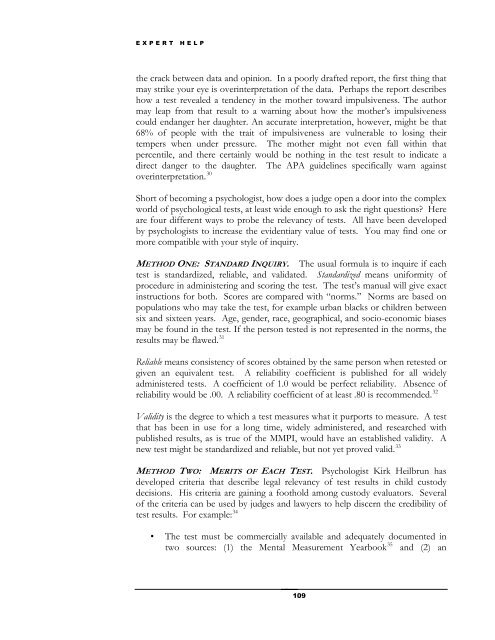A Judge’s Guide
A Judge’s Guide
A Judge’s Guide
Create successful ePaper yourself
Turn your PDF publications into a flip-book with our unique Google optimized e-Paper software.
EXPERT HELP<br />
the crack between data and opinion. In a poorly drafted report, the first thing that<br />
may strike your eye is overinterpretation of the data. Perhaps the report describes<br />
how a test revealed a tendency in the mother toward impulsiveness. The author<br />
may leap from that result to a warning about how the mother’s impulsiveness<br />
could endanger her daughter. An accurate interpretation, however, might be that<br />
68% of people with the trait of impulsiveness are vulnerable to losing their<br />
tempers when under pressure. The mother might not even fall within that<br />
percentile, and there certainly would be nothing in the test result to indicate a<br />
direct danger to the daughter. The APA guidelines specifically warn against<br />
overinterpretation. 30<br />
Short of becoming a psychologist, how does a judge open a door into the complex<br />
world of psychological tests, at least wide enough to ask the right questions? Here<br />
are four different ways to probe the relevancy of tests. All have been developed<br />
by psychologists to increase the evidentiary value of tests. You may find one or<br />
more compatible with your style of inquiry.<br />
METHOD ONE: STANDARD INQUIRY. The usual formula is to inquire if each<br />
test is standardized, reliable, and validated. Standardized means uniformity of<br />
procedure in administering and scoring the test. The test’s manual will give exact<br />
instructions for both. Scores are compared with “norms.” Norms are based on<br />
populations who may take the test, for example urban blacks or children between<br />
six and sixteen years. Age, gender, race, geographical, and socio-economic biases<br />
may be found in the test. If the person tested is not represented in the norms, the<br />
results may be flawed. 31<br />
Reliable means consistency of scores obtained by the same person when retested or<br />
given an equivalent test. A reliability coefficient is published for all widely<br />
administered tests. A coefficient of 1.0 would be perfect reliability. Absence of<br />
reliability would be .00. A reliability coefficient of at least .80 is recommended. 32<br />
Validity is the degree to which a test measures what it purports to measure. A test<br />
that has been in use for a long time, widely administered, and researched with<br />
published results, as is true of the MMPI, would have an established validity. A<br />
new test might be standardized and reliable, but not yet proved valid. 33<br />
METHOD TWO: MERITS OF EACH TEST. Psychologist Kirk Heilbrun has<br />
developed criteria that describe legal relevancy of test results in child custody<br />
decisions. His criteria are gaining a foothold among custody evaluators. Several<br />
of the criteria can be used by judges and lawyers to help discern the credibility of<br />
test results. For example: 34<br />
• The test must be commercially available and adequately documented in<br />
two sources: (1) the Mental Measurement Yearbook 35 and (2) an<br />
109 109


